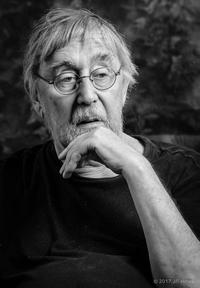Olaf Hanel
Weight and troubles pull us down. The bones dry out and the mind subsides. But like the raised finger of John the Baptist, Olaf Hanel’s message resonates: recall physical movement and the flight of the soul upwards. His message is carried by poetic bubbles in his cycles of works on paper, the statue of towers of buckets or thimbles, drawings that recall ideal vertebrae. Eugen Brikcius speaks of Hanel’s “perpendicular ecstasy”.
Tall, slender and alone like his statues, turned with his face toward the skies. Olaf Hanel patiently adds line to line in his laborious drawings and graphics. He balances colors of whirling rings, which break away from the chaos and resemble mandalas. He continually changes his artistic expression save a single exception: Bubbles. He has been resuscitating them for 40 years — he breathes life into his India ink bubbles, which he catches and “pins” on paper like rare butterflies. To his great pleasure, both black and colored leave an impression on the paper.
In the aridity of this year’s summer we believe even in the distant waving of butterfly wings. Somewhere high above, the wind will disperse the wave, which will bring us at least a few drops of rain. Let Hanel’s bubbles be a portent of our hopes and delight before it really begins to rain.
Pavlína Bartoňová
Perpendicular Extasy
Olaf Hanel, a distinguished member of The Crusaders’ School of Pure Humor Without Wit studied art education and later also taught it. Soon, however, he left his students and began to concentrate his teaching on himself. He diligently pursued both sports and inventions. Take, for example, the discipline known by the name of volleyball. Within the framework of volleyball, artistically understood, he invented and premiered the service smash. Now everyone employs his bounding service, even otherwise decent female volleyball players.
Despite all the vigor it is a matter of a distinctive artistic influence, not to mention the fact that if the server soars high enough he cannot miss hearing the music of the heavenly spheres, which he has so impudently approached. Here lies the heart of the matter. Hanel influences his environment artistically, and not only on the sports field. The inventor accepts the mass imitation of his groundbreaking work as self-evident. After all, it concerns a dimension of ecstasy, which is quite common in his work. In his most recent exhibition, his works literally radiate this ecstatic inspiration. More succinctly we might say that the works on exhibit are in effect a serve, which the artist smashes with consummate skill. Thanks to Hanel’s artistic contribution, the ball game has become art, and the exhibited works then flaunt their inspiring spirit.
Our artist also dabbled in track and field. Besides the high jump, which foreshadowed his later propensity for vertical, columnar artifacts, he also devoted himself to racewalking. Hanel the cross-country walker physically entered the countryside. But so as not to merge with it, he began to oppose it artistically. He settled temporarily on Land Art — a genre, which is actually supposed to work out the philosophy of the countryside. Convinced of the necessity of entering aesthetically into the terrain of the landscape itself, he prepared in his atelier artifacts to be installed in the countryside and graphic models for interventions into it. His “Tribute to the Radiant Stars” became legendary. On 21 March 1972, around a hundred tin film canisters filled with flammable material were placed within an area of one hectare in the shape of the constellation of stars in the spring sky. A bus from Prague full of participants arrived at the site of the event in order to participate in the lighting of the cannisters at the hour of the spring equinox. Jindřich Chalupecký was also there and nodded his head in approval.
When the passengers of the Prague–Brno express in 1973 sounded the mournful horn of the “Steam organ,” it sounded like the death knell of the period of Land Art. Unwavering, Hanel switched to bubble drawings and graphic art. The artist would don eyeglasses made of tea strainers and blow aesthetic bubbles onto the naked body of a model. During his residence in Canada came his period of objects made of wire mesh, sometimes partially filled, and paintings inspired by the countryside. Upon returning to his homeland, the question whether he should go from his atelier to the fields or from the fields to his atelier ceased to exist. He no longer worried about a horizontal shuffling back and forth. Just as during his youthful high jumping, he began to catapult his work. After his mesh mounds came a series of columns of buckets which, like trees, grew into the sky, but into an artistic sky. No hamadryads resided at their peaks, but rather bashful muses. Of course, the latter, as a rule, do not appear in the realm of visual art. They simply do not occur among the daughters of the goddess Mnemosyne. This, however, did not deter Hanel.
Even today many refer to him as a conceptual artist, but not even this simplification can disturb the old pioneer. After all, unlike fundamental conceptualists for whom a work ends with the first phase of the idea, he dutifully realizes his concepts, which are often very graphic. Furthermore, he has mastered painting. This is simply how he is. It seems that this teacher educated himself in the graphic arts. He became an artist with primarily precipitous traits. Nearly a half century ago the starry firmament lit up on the meadows near Světlá. Today the artist prefers to leave the sky above so that he can aim for it with his supremely earthly creations.
Eugen Brikcius
Translation Craig Cravens





